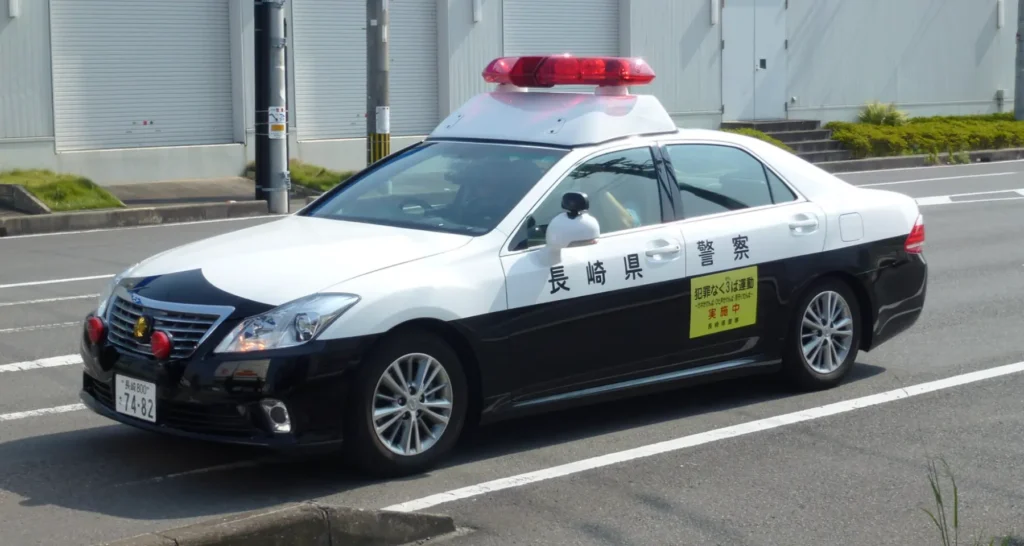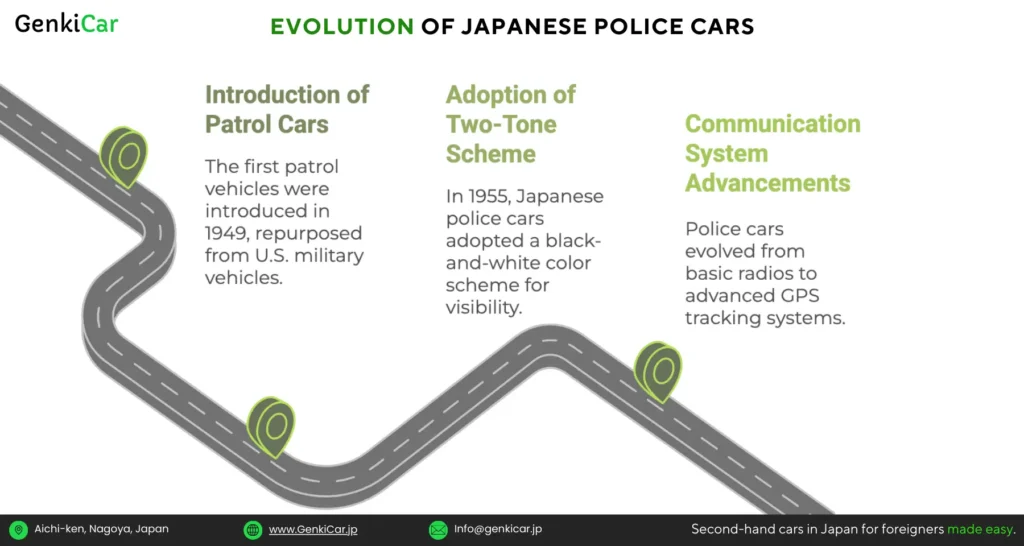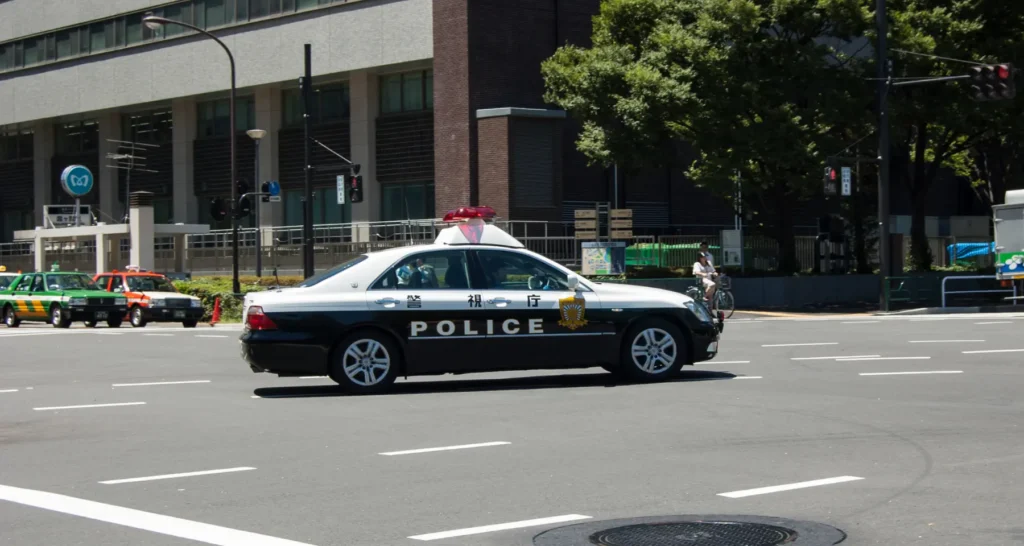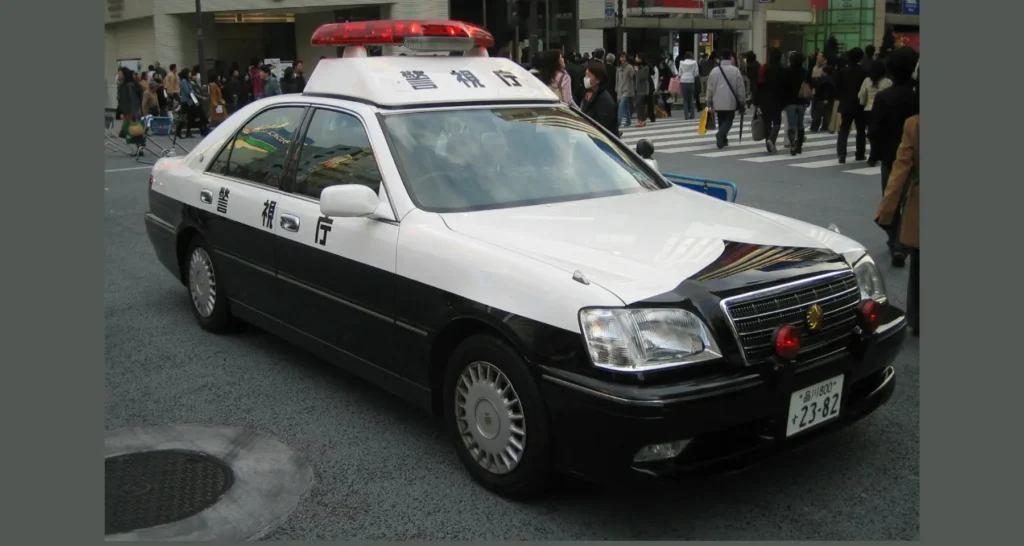The Iconic Black-and-White Design
Japanese police cars are instantly recognizable due to their distinctive black-and-white color scheme. This design choice, adopted in 1955, gives them high visibility and authority on the roads. The design was initially chosen to help distinguish police vehicles from civilian cars and remains a functional and symbolic hallmark of law enforcement in Japan. It also serves a practical purpose in hiding dirt and wear, which is particularly useful during extensive patrolling.
Japanese Police Cars and Digital Display Boards
One of the most innovative features of Japanese police cars is the inclusion of digital display boards. These electronic boards, typically mounted on the rear of the vehicle, allow officers to communicate directly with other drivers on the road. To accommodate Japan’s 33 million annual tourists and foreign residents, many boards toggle between Japanese and English Messages such as “Reduce Speed” or “Follow Me”, “Accident Ahead” (前方事故あり / Jōhō jiko ari), “Please Follow Me” (従ってください / Shitagatte kudasai) are commonly displayed to provide clear instructions during traffic stops, emergencies, or road management. This is not only to provide efficiency of police operations but also to make sure that drivers, including those unfamiliar with Japanese traffic systems, can quickly understand and respond to instructions.

Start your journey toward car ownership in Japan! Fill out our form, and we’ll connect you with a dealership that speaks your language and can guide you through every step.
Top 5 Most Common Japanese Police Car Models
Toyota Crown
The Toyota Crown has long been a cornerstone of Japanese police fleets, valued for its reliability, durability, and versatility. This sedan is particularly suited to routine patrolling and traffic enforcement, offering ample interior space for officers and their equipment. Its fuel efficiency and low maintenance costs make it a practical choice for extended use. The Crown’s ability to balance comfort and performance ensures it remains a favorite among law enforcement agencies.
Nissan GT-R (R35)
The Nissan GT-R, often referred to as “Godzilla” for its legendary performance, serves as the high-speed enforcer of Japanese police cars. Introduced to the fleet in 2018, the GT-R is primarily used for highway patrols and high-speed pursuits. Its 565-horsepower engine and precision handling make it ideal for situations requiring rapid response and superior control. The GT-R’s inclusion underscores Japan’s emphasis on equipping law enforcement with the best tools for specialized operations.
To maintain peak performance, police vehicles undergo regular servicing and inspections, following strict standards similar to those found in Car Maintenance in Japan. Proper upkeep ensures reliability, especially for high-performance models like the Nissan GT-R and Lexus LC500.
Lexus LC500
For a touch of sophistication, the Lexus LC500 joins the ranks of Japanese police vehicles. Known for its luxurious design and high-performance capabilities, the LC500 is often used for tasks that require both speed and style. Its sleek profile and advanced technology not only enhance operational efficiency but also symbolize the modern and forward-thinking approach of Japan’s police force. While less common than the Crown or GT-R, the LC500 adds a premium edge to the fleet.
Toyota Mirai: Leading the Way in Eco-Friendly Policing
The Toyota Mirai represents Japan’s commitment to sustainability, being one of the first hydrogen-powered vehicles in the police fleet. This eco-friendly sedan is used in areas focused on reducing carbon emissions, such as urban centers and regions with heavy traffic. The Mirai combines innovation with practicality, offering zero emissions without compromising performance. Its integration into the fleet highlights Japan’s forward-looking approach to law enforcement.
Mazda RX-8
The Mazda RX-8, known for its compact design and rotary engine, is perfectly suited for urban patrolling. Its lightweight frame and exceptional maneuverability allow officers to navigate tight city streets with ease. While not as powerful as the GT-R, the RX-8 excels in urban environments where agility and quick response times are critical. This car’s role in the fleet demonstrates the diversity of vehicles tailored to meet specific policing needs.
Want to explore electric or hybrid cars in Japan? Complete our form to get connected with a dealership knowledgeable in eco-friendly models for foreign residents.
How Have Japanese Police Cars Evolved Over the Years?

The Birth of Patrol Cars in 1949
The journey of Japanese police cars began in 1949 when the first patrol vehicles were introduced at the Asakusa Police Station in Tokyo. These cars were repurposed from U.S. military vehicles left in Japan after World War II. Initially referred to as “mobile police units” (移動警察), these vehicles provided officers with greater mobility and the ability to respond quickly to incidents. They marked a significant shift from foot patrols to motorized policing, laying the groundwork for modern law enforcement in Japan.
Adoption of the Two-Tone Color Scheme in 1955
In 1955, Japanese police cars adopted the now-iconic black-and-white color scheme. This design choice was driven by both practicality and visibility. The stark contrast between the black lower half and white upper half ensured that the vehicles were easily recognizable on the road, even in low-light conditions. At the time, it also distinguished police cars from the mostly white civilian vehicles of the era. This two-tone scheme remains a defining characteristic of Japanese police cars and is recognized as a symbol of authority and order.
From Basic Radios to Advanced GPS Tracking Systems
The early patrol cars were equipped with rudimentary radio systems, allowing officers to communicate with their headquarters. Over the years, these basic radios evolved into highly sophisticated communication systems. Today, Japanese police cars are outfitted with advanced GPS tracking systems that provide real-time location data, enabling dispatchers to coordinate responses efficiently. Additional integrations, such as onboard computers, automatic license plate recognition (ANPR), and digital cameras, have transformed the cars.
Are Japanese Police Cars Going Green?

Japan’s commitment to sustainability and its 2030 Goals is evident in the adoption of the hydrogen-powered Toyota Mirai within its police fleet. As one of the first hydrogen fuel cell vehicles (FCVs) used in law enforcement, the Mirai produces zero emissions, making it an eco-friendly alternative to traditional patrol cars. Despite its environmentally conscious design, the Mirai delivers excellent performance, with a long driving range and quick refueling capabilities, ensuring it meets the operational demands of police work. Its introduction reflects Japan’s ambition to reduce carbon emissions while maintaining the efficiency of its law enforcement vehicles.
Eco-Friendly Policies in Law Enforcement
The integration of eco-friendly vehicles like zero-emission cars into police fleets is part of a larger initiative to promote sustainability in public sectors. Japanese law enforcement agencies are increasingly prioritizing the reduction of greenhouse gas emissions, aligning with the nation’s broader environmental goals. Aiming at transitioning from gasoline-powered vehicles to hybrids, hydrogen-powered models, and electric vehicles (EVs). These policies contribute to combating climate change and also set an example for other public services to adopt greener practices. As the public demands.
The Future of Electric and Autonomous Patrol Cars
Looking ahead, Japanese police are exploring the potential of fully electric and autonomous patrol cars. Electric vehicles (EVs) are expected to become a key component of police fleets, offering zero-emission operation with advancements in battery technology ensuring extended range and faster charging. Autonomous patrol cars, equipped with artificial intelligence (AI) and self-driving capabilities, are also perhaps on the horizon. Although unlikely to happen soon, such cars could revolutionize law enforcement by enabling more efficient patrolling, real-time crime detection, and enhanced safety for officers and the public.
Just like you and I, Japanese police cars must adhere to Japanese Traffic Laws, which regulate speed limits, patrol operations, and emergency response procedures.
What Can Other Nations Learn from Japanese Police Cars?

The Importance of Public Communication
Japanese police cars excel in public communication, thanks to their use of digital display boards which convey clear and concise messages to drivers and pedestrians, often in multiple languages like Japanese and English. Such features make effective communication in real-time, even with non-native speakers. Other countries can adopt similar systems to enhance public interaction, improve traffic management, and foster better relationships between law enforcement and the community. Maybe less noise-pollution as well. The focus on transparency and inclusivity makes Japanese police cars a model for global policing practices.
Sustainability in Law Enforcement
Japan’s adoption of eco-friendly cars aligns with global efforts to combat climate change and demonstrates how law enforcement agencies can also contribute to broader environmental goals. By integrating hydrogen-powered, electric cars and Hybrid into their fleets, Japanese police cars pave the way for a greener future in law enforcement. Other countries can follow suit by adopting similar eco-friendly policies, showcasing that environmental responsibility and effective policing can go hand in hand.





